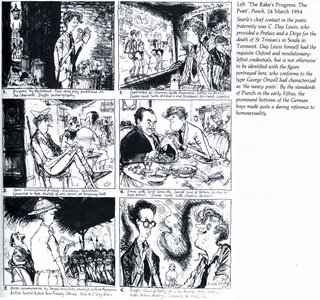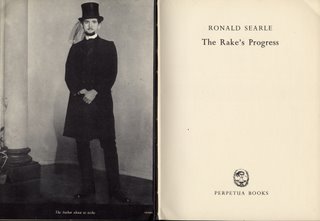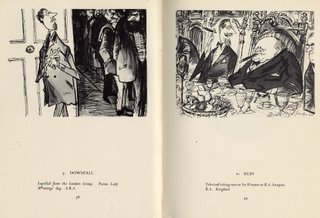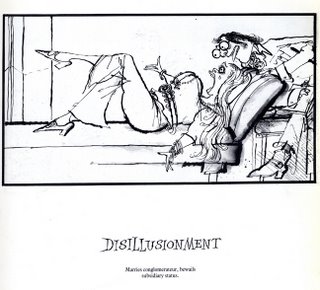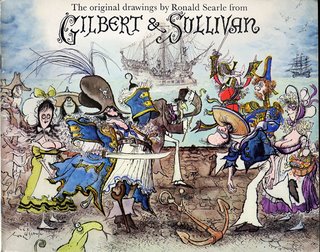
In 1975 Bill Melendez produced an animated feature called
DICK DEADEYE, based on the operas of
Gilbert & Sullivan. Ronald Searle was engaged to design the characters but of course the animators coudn't come close to matching his style or line. The film is still interesting as Searle painted a lot of the backgrounds himself. There is a
DICK DEADEYE book telling the story of the film with animation drawings & Searle's backgrounds. It would be an unremarkable publication if not for a scant few 'turnaround' modelsheets made by Searle for the animators to follow. I recently came across a seperate volume comprising PURELY Searle's designs for the film. Here are a few:
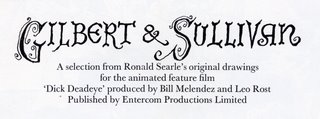
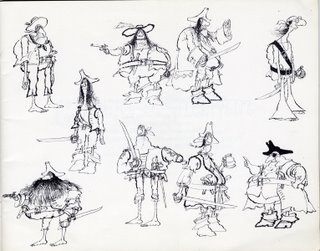
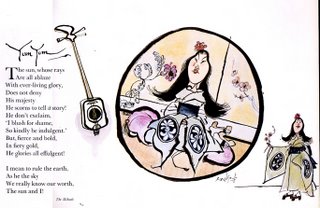
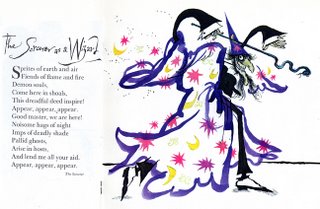
The following appear in the DICK DEADEYE book:
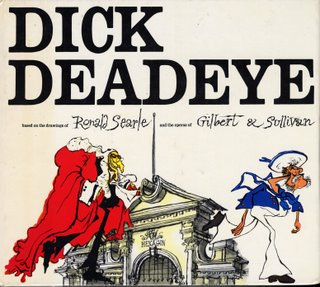
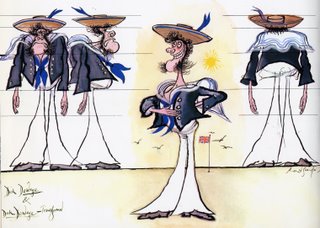
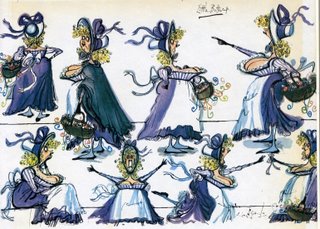
Sketchbook roughs for the above
The book features several backgrounds painted by Searle, although I believe certain production backgrounds were created by painters following Searle's style.
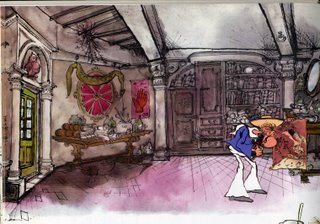
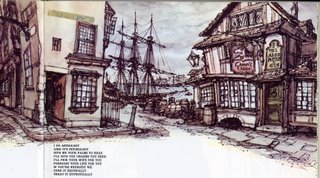
These family portraits definitely seem to be by Searle's hand.
'The Sorcerer'

The Sorcerer as the Major General

Menu from the
Canberra from 11 July 1977 with a design by Ronald Searle called
'The Monarch of the Sea' originally for the animated film
'Dick Deadeye'.



Sketchbook rough






'Ken Clark chats with Dick and Elizabeth Horn'
"I joined Melendez in the Autumn of ‘72 working on the Away-Day adverts for British Rail. I guess I was in the right place at the right time when Steve Melendez first showed me the original storyboard for “Dick Deadeye”. I didn’t look at it too closely at the time, being the pessimist I am, I didn’t believe it would actually happen – it just seemed too good to be true! Consider; a full-length cartoon based on Gilbert & Sullivan operas, backed by Leo Rost, designed by Ronald Searle, Directed by Bill Melendez and animated here, in London? No mate! I thought, better get on with the commercials and leave the pipe-dreams to others.
Well, it proved to be more than a dream. By the following Easter, newly-refurbished premises had been acquired at the top of Carnaby Street and animators and layout men set to work. Jaques Vausseur formerly of Cineastes Associes in Paris was in charge of
animation with Bill popping over from time to time to spur us on or bawl us out as the occasion demanded, I had worked with Jaques before and had a great respect for his draughtsmanship and animation skills so I could hardly wait to get in to work each day, especially when I found myself working for the first time in a newly decorated room with the sun streaming through the window, brand new equipment and freshly-made coffee on tap all day! I felt I should be paying them!

Some weeks later the first scenes appeared in line-test form and I began to have misgivings; the quality was variable to say the least but I consoled myself with the thought that these were early days and with Bill and Jaques in charge all would be well before long, and I clung to this thought for the rest of the year despite the obvious lack of experience shown by too many of the animators, most of whom I’d never met before.
In June ‘74 I returned from holiday to learn that Jaques had died from a heart attack while I was away. This in itself was a shock but hardly had I absorbed this fact when Bill called me in and asked me to take over as Animation Director. My feelings wavered between elation and sheer panic but I reckoned the least I could do was try.
By now the layouts were finished, Bill’s visits had become less frequent due to pressure of work in L.A. and so the onus was on Steve Melendez and me to get the thing through. Fortunately, we worked well together, and Steve’s energy rand versatility in handling the editing and work flow enabled me to cope with the animation side. I soon discovered that the luxury of sitting at a desk drawing was something that had to be fitted in at the end of a day given over to preparing timing and layouts, briefing animators, even finding animators, checking line-tests and rushes, making corrections, and trying to keep pace with last-minute changes in the story. It was at this point that I discovered for the first time how few animators can actually draw – but that’s a subject on which I could sound off at length!

The story meetings tended to be free-wheeling affairs led by Leo Rost, a larger than life character who was the chief backer of the project, aided by Victor Spinetti who was the voice of Dick Deadeye. As well as contributing jokes to the film Victor regaled us with extensive autobiographical revelations, the effect of which was to induce a state of collective hysteria which in turn generated more ideas than we could possibly use and it became part of my job to edit these down to a form that would not distort the basic story structure already in existence.
By the end of 1974 we were under pressure to wrap the film so that it would be ready for exhibition by Easter ‘75. There was still much to be done and alas, in my opinion much that needed to be re-done, but Steve persuaded me that decisive editing was the answer and so I concentrated on getting the scenes animated in time and desperately trying to get the drawings to resemble the original models, while Steve hacked away in the cutting room.
I was not involved with the final editing and dubbing which was done by Steve and Bill in Los Angeles and I therefore plead diminished responsibility for the result!"
The following are photographed from the originals in the collection of the
Wilhelm-Busch Museum, Hanover.
Here are pages from Searle's preparatory sketchbook for the project.
Searle's preparatory sketchbooks photographed from video installation at the Searle Archive, Hanover. It's interesting to see how Searle explored the material quite conventionally at first before letting his cartoon imagination run -





























